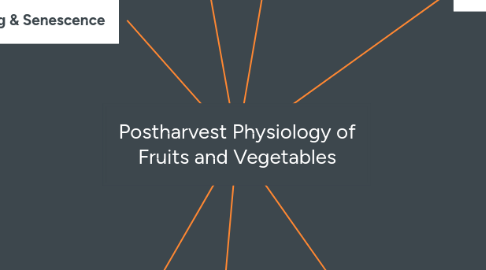
1. Other Biochemical Changes
1.1. Chemical and enzymatic changes
1.1.1. Tissue softening
1.1.1.1. Hydrolysis of starch and cellulose by amylases and cellulose enzymes
1.1.2. Off flavors
1.1.3. Pigment loss
1.1.4. Decline in nutritional value
1.1.5. Taste.
2. Transpiration & Water Stress
2.1. Transpiration
2.1.1. A process of mass transfer in which the water vapors move from the surface of the produce to the surrounding atmosphere.
2.2. Rate of transpiration
2.2.1. Skin structure, size, shape, surface area, water vapor pressure difference, air movement, heat of respiration, the level of maturity
2.2.2. The higher the ratio of surface area to volume, the greater the loss of water by evaporation.
2.2.3. Immature fruits have higher rate of transpiration
2.3. Regulation Water Loss
2.3.1. Outer protective coverings, number of stomata,
2.4. Factors affecting Water Loss
2.4.1. Temperature, RH, and air movement
2.5. Minimization of Water Loss
2.5.1. Maintaining higher pressure than atmosphere, maintaining low temperature and humidity during storage, choice of suitable packaging material, and loading density and depth,
3. Ripening & Senescence
3.1. Ripening
3.1.1. Stage in tissue development when a fruit reaches an optimal eating quality
3.1.1.1. Induces changes that are structural, physical, chemical, nutritional, biochemical, or enzymatic.
3.1.1.1.1. Degradative
3.1.1.1.2. Synthetic
3.2. Senescence
3.2.1. Genetically programmed and induced by common stressors, such as tissue injury, deficiency of nutrients and water during production
4. Phytohormone Effects
4.1. Phytohormones
4.1.1. Control the growth and development processes of plant (plant metabolism)
4.2. Physiological Processes by Hormones
4.2.1. Ripening, rest, dormancy, rooting, sprouting, abscission, and floral induction
4.3. Ethylene
4.3.1. Regulates many aspects of growth and development
4.3.2. Stimulates ripening of climacteric and some non-climacteric fruits,
4.3.3. Synthesis of anthocyanins
4.3.4. Germination of seeds
4.3.5. Degradation of chlorophyll
4.3.6. Formation of adventitious roots, flower
4.3.7. Flower initiation
4.3.8. Respiratory and phenyl propanoid metabolism
4.3.9. Abscission and senescence,
5. Ontogeny
5.1. Definition: The origin & Development (of plants)
5.2. 5 Distinct Development Phases (Fruit & Vegetables)
5.2.1. Development
5.2.2. Young/Premature
5.2.3. Mature
5.2.4. Ripe
5.2.5. Senescence
5.3. The duration of these of ages vary with type of product & stage development
6. Respiration
6.1. Conversion of glucose & O2 to CO2, H2O & release energy (in plants)
6.2. Indicator of metabolic activity that is significant to postharvest physiology & deterioration of quality of plant foods.
6.3. Rate of deterioration proportional to respiration rate
6.3.1. Higher respiration rate, shorter the shelf life
6.3.2. Respiration increases, storage temperature increases
6.4. Internal Factors
6.4.1. Quantity of substrate, size, shape, cell morphology,
6.5. Temperature
6.5.1. Climateric fruits
6.5.1.1. Harvested mature and ripened off the plant.
6.5.1.2. Produce much larger quantities of ethylene due to ripening which results in uniform ripening.
6.5.2. Non-climateric fruits
6.5.2.1. Ripen only on the tree
7. Physiological Disorders & Breakdowns
7.1. Physiological Disorders are due to metabolic disturbances cause by a host of internal and external factors
7.1.1. Mineral Deficiencies from nutrients in the soil
7.1.2. Low-Temperature Injuries or Disorders
7.1.2.1. Chilling Injuries
7.1.2.2. Freezing Injury
7.1.3. High-Temperature Injuries or Disorders
7.1.3.1. Exposure to high temperature cause inability to ripen
7.1.3.2. Long exposure to sun
7.1.4. Injuries/Disorders due to Exposure to Adverse Atmosphere
7.1.4.1. Exposure to low levels of O2 and high levels of CO2
7.1.4.2. Internal Browning
7.2. Breakdown
7.2.1. Temperatures
7.2.2. Altered atmospheric gasconcentrations
7.2.3. Internal breakdown (Brown heart)
7.2.4. Nutrition

